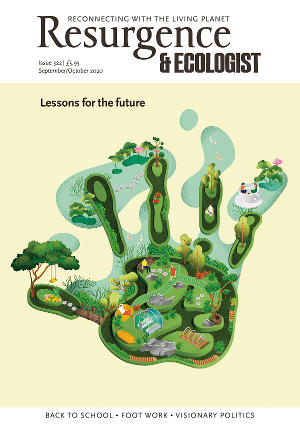Just how do you follow an epic 630-mile journey on foot – one in which you confronted homelessness, terminal illness, hunger, thirst, sunstroke, rainstorms and virtual poverty? And, now that it has ended, how do you replace the sense of meaning that suffused each day of your life-changing experience? This was the challenge confronting Raynor Winn, in both her life and her writing, in the follow-up to her bestselling travel memoir, The Salt Path.
In the final pages of The Salt Path we left Winn and her husband Moth at the end of their walk along the South West Coast Path, temporarily living in a small flat on the Cornish coast. This is where The Wild Silence picks up the story, and we now find Winn waking up every day in her “new empty life” with no job, very little money and her mother dying in hospital. The Salt Path is yet to be written, and after Moth sets off each day for the local university to study sustainable horticulture Winn opens her laptop, hunting for jobs and researching into Moth’s neurodegenerative illness, CBD.
As she describes in The Wild Silence, it’s while investigating CBD that Winn uncovers evidence suggesting that extreme physical activity, such as they underwent while walking the coast path, can reverse some of the symptoms of the illness. And, along with further proof of the physical and mental benefits of being immersed in the natural world, Winn’s hope in a Nature therapy for Moth – and a possible future for them both – is renewed.
Meanwhile, living in a tiny, gardenless flat, tentatively making new friends at the local WI (which is not her usual habitat), Winn begins writing about their transformative walk for the benefit of Moth, who is now losing his memory to CBD. Then, when The Salt Path is unexpectedly published, she’s contacted by a landowner who, having read the book, offers them an opportunity to reconnect more deeply with their adoptive Cornish homeland.
The Wild Silence is a very different book from The Salt Path, which chronicles a single episode in Winn’s life: the arduous walk along the coast path, their past life obliterated and their future terrifyingly uncertain. During that walk Winn learned to live in the here and now, her whole being concentrated on placing one boot in front of the other for hundreds of miles. The Wild Silence bookends that journey, delving into Winn’s rural childhood, relating the backstory of her relationship with Moth and her burgeoning relationship with the natural world. And, in an echo of The Salt Path, another demanding journey on foot, this time across the dramatic terrain of southern Iceland.
Interweaving past and present, Cornwall, Wales and the Midlands where Winn grew up, this is a book about the oneness of all living things, the power of serendipity to shape lives, hope triumphing over despair, and the healing energy of Nature for both body and soul. Above all, it is a book about love – the enduring love between two people, and the profound love of humans for their landscape.
It’s not necessary to have read The Salt Path to enjoy this more artful sequel, which works well as a stand-alone book and reveals Winn’s evolution as a writer. Inevitably, the lack of a single linear journey, with its life-or-death jeopardy, in The Wild Silence means that some of the cliff-hanging narrative tension of the previous book is absent. Yet the couple still find themselves living a precarious existence in their new, more settled life, while the quality of Winn’s writing draws us through the story with the same emotional honesty, lyricism and warmth that epitomises The Salt Path.







